Mark Sisson's Blog, page 273
January 22, 2015
What Is the Point of Your 21-Day Challenge? (Plus a Contest)
 Last week I kicked things off by saying it was time to make this 21-Day Challenge personal. In other words, I asked, what were you done with? What behaviors, conditions or trajectories were you ready to jettison to welcome a healthier, more vital life? I think it’s always critical to identify what isn’t working for us at any given time. When we’re clear on what doesn’t fit our intentions for our lives, we can cleanly let go and move forward.
Last week I kicked things off by saying it was time to make this 21-Day Challenge personal. In other words, I asked, what were you done with? What behaviors, conditions or trajectories were you ready to jettison to welcome a healthier, more vital life? I think it’s always critical to identify what isn’t working for us at any given time. When we’re clear on what doesn’t fit our intentions for our lives, we can cleanly let go and move forward.
That said, I don’t believe change itself comes from negative assessments, and I appreciated readers’ comments last week that affirmed the power of positive language. The fact is, when you come at anything in life from a mental place of lack – diminished self-esteem, low expectations, small thinking, little self-worth, fearful scarcity, poor confidence – you’re setting yourself up for a meager win if not outright failure. In that regard, it’s a question of efficacy. If you don’t see yourself as a cause worthy of investment, if you don’t believe in your inherent power, if you hedge your bets out of cynicism or anxiety, you’re cutting off your endeavor at the knees – right from the start.
And yet it’s also a matter of purpose.
We can and need on some level to discern what’s not working, but the journey itself isn’t about what’s lacking. When we view these 21 days (or any day) as a means to an end – a Challenge goal, a better race time, a lower weight, a better job, a new relationship, a healthier biomarker – no matter how good the intention we’re ultimately missing an opportunity – and maybe the central point.
The real point of taking the Challenge – however you’ve made it your own – is to live a better life. Maybe a longer life is part of the vision for some of you, but I’d venture to say a better life is the real underlying commonality. Living a awesome life – this is the chance available to you right now.
And there’s the critical factor – “right now.”
Put aside for a minute what you want the Challenge to “fix” or eliminate. What would it meant to live vitally in your body right now – as is? Yes, we’re ultimately working toward a deeper, more expansive vitality with all our efforts, but what if we made the choice to see the process less as a path of hard discipline and more a journey of self-valuing – and (dare I say) celebration?
Take a minute and look at your body with an eye for appreciation. Assess what it can do and what it’s seen you through. Look at your life from the angle of abundance. What is good? Your body isn’t the enemy here after all. Consider how amazing it is to walk and jump and lift your child or move all your belongings, to build and travel. Just as we can reframe and celebrate eating amazing healthy food and living an active life, we can reframe how we view the bodies we want to nurture into healthier, more vibrant being – because why wouldn’t we offer them such an adventure, why would we shortchange our bodies, ourselves, such an opportunity to live the fullest life possible?
Our bodies don’t need to be perfect to deserve this privilege just as our diet doesn’t need to be 100% Primal. The privilege is ours because we want it and take it – if we allow ourselves that pleasure. On the path to vitality, it’s less about noting what’s bad and doesn’t serve us anymore and more about – when we get those amazing glimpses into this level of experience – what’s great. Then we can unabashedly declare “More of THAT, please!” and subsequently live ourselves into that vision.
So, are the two perspectives of “What’s not working?” and “What can I celebrate right now?” mutually exclusive? I don’t think they are. For instance, being sick or significantly overweight are urgent matters that deserve our attention. That being said, it’s not about being shaken into seeing how “broken” we are physically, metabolically or psychologically. It’s not about reaching a level of self-disgust to be motivated to change.
It’s simply about saying, “This isn’t working for me anymore.” Last week’s post got at the “this” – the many forms “this” can take. What’s equally important to emphasize in the statement, however, is the phrase “for me.”
For me. For myself… (We’ll put aside the finer points of grammar for a moment.) What do I want for myself? What do I want to savor in this life for myself? What do I desire to take pleasure in, to bask in? What do I want to cultivate into being for myself?
Embracing vitality means not placating oneself with the way things are out of a misplaced sense of “accepting myself means accepting whatever is.” However, it also doesn’t oblige us to delay feeling reverence for the body, to defer reaching for euphoria and thrill, to postpone relishing one’s life.
It means beginning to live differently today.
So, for today I have a modest proposal. Take as you wish – and apply it to every day going forward in this Challenge. See this day as important as the final day of the Challenge. What you live and enjoy today is equally as important as the results you’ll measure on February 1. Seek out peak experiences. Indulge in healthy pleasures. Luxuriate in what is life-giving and nourishing. Committing to a healthy life entails committing to the full rewards and responsibilities. That day begins now.
Thanks for reading, everyone. What can you embrace today as a commitment to the rewards of a healthy, vigorous life?
The Contest:
Leave a comment in the comment board below and you’ll automatically be entered to win a Focal Upright “Mogo”. One winner will be selected at random. This contest expires today, Jan. 22, at 11:59 pm PST.
The Prize:
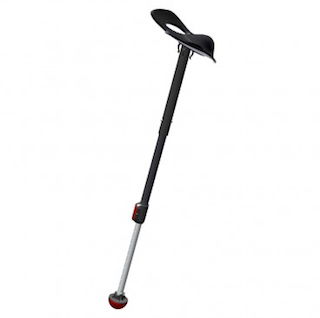 Focal Upright “Mogo”- You might recall my “leaning workstation” as seen in the How-to: Standup and Mobile Workstations video from last year, the Locus Seat from Focal. It’s sort of a human kickstand that allows me to alternate between leaning and standing. Leaning is kind of like sitting in that it takes the load off, just without shortening your hip flexors and turning your glutes into a amorphous gelatinous blobs. I love it.
Focal Upright “Mogo”- You might recall my “leaning workstation” as seen in the How-to: Standup and Mobile Workstations video from last year, the Locus Seat from Focal. It’s sort of a human kickstand that allows me to alternate between leaning and standing. Leaning is kind of like sitting in that it takes the load off, just without shortening your hip flexors and turning your glutes into a amorphous gelatinous blobs. I love it.
If you liked the look of it and want something similar, you’ll love the Mogo. It’s also made by Focal, and it’s of a similar design and also allows you to lean and stand, but it’s less expensive and more mobile, weighing just over 2 pounds and collapsing for easy storage. That means you can take it along with you to the office, the cafe, the great outdoors (laptop on a stump, anyone?), or when you travel, and get strange looks and lots of questions while you get work done. Retail Value: $99.



January 21, 2015
11 Ways to Assess Your True Fitness Level
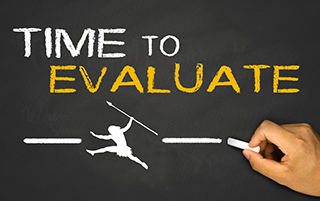 I once dated a girl who only went to the gym once a month. She’d do the same workout — a tough, high-intensity circuit using weights, the stationary bike, the stepper, and a few other machines — every single time, and that was it.
I once dated a girl who only went to the gym once a month. She’d do the same workout — a tough, high-intensity circuit using weights, the stationary bike, the stepper, and a few other machines — every single time, and that was it.
When you asked her about it, her reasoning was that if she could do the workout, she was still fit and that was enough for her. Why go to the gym every day if she was already in shape?
While I wouldn’t recommend that methodology myself, one thing she did have right was regularly assessing her fitness level. This is something that most people – even many of the fitness buffs amongst us – don’t do, and I think that’s a real mistake.
With the Challenge underway, I thought we’d explore this topic. Do you have a measuring post to gauge how fit you are? Is there a standard you aspire to reach? To surpass? To maintain?
Let’s look at several ways you can assess your true fitness level.
1. Do the Primal Blueprint Fitness assessment.
This is a simple way to check your capacity for bodyweight fitness. Do the max number of consecutive reps for each Primal Essential Movement. The number of reps you complete in each movement will determine where to begin on that movement’s progression.
If you haven’t already, sign up for the newsletter and get free access to the Primal Blueprint Fitness e-book.
2. Do the CrossFit baseline WOD.
For time, do:
500 meter row
40 bodyweight squats — full depth, hip crease below knee
30 situps — start with shoulders touching the ground
20 pushups — chest to floor
10 pullups — chin above bar, full extension at the bottom
That’s a very reasonable standard. It tests strength, strength-endurance, and the ability to endure a demanding workout. Here’s how CrossFit interprets times (Male/Female):
3:45, 4:40 — Elite
4:30, 5:35 — Pro
5:15, 6:30 — Expert
6:15, 7:30 — Collegiate
7:15, 8:30 — Intermediate
8:15, 9:30 — Novice
9:15, 10:30 — Beginner
10:00, 11:00 — Cut-Off
3. Run a mile.
I talked about this extensively several months ago. The mile run really is a nice barometer for overall, “real-world” endurance fitness. A mile’s about as long as you’ll have to run in an “emergency” nowadays, whether it’s back to your apartment because you forgot your phone or through city streets because it just started pouring all of a sudden. Even if you’ve just defeated the Persian army and need to warn your countrymen that the remaining fighters are heading their way with revenge on their minds, you send a text. You don’t run the 26.2 miles back to tell them in person. If anything, you might run around for a mile’s worth, searching for a signal.
In a recent study, men over 50 who could run the mile in 8 minutes or less had “optimal cardiovascular fitness” and a greatly reduced risk of heart disease. For women, it was 9 minutes.
Any fit person, man or woman, should aim for at least 8 minutes or less. The younger you are, the less time it should take. But the best mark of fitness is that your time improves.
4. Do the maximum aerobic function test.
For regular folks, general trainees and athletes, the mile run is a great barometer of the kind of aerobic fitness they’d need. For more serious endurance athletes, the maximum aerobic function (MAF) test is worthwhile.
Phil Maffetone came up with the MAF, and it’s pretty simple and intuitive. Best for endurance athletes, but anyone interested in their aerobic capacity (which should be everyone, probably) can benefit from taking the test.
Find a fixed course (like a track) and strap on a heart rate monitor.
Start slowly running until you reach 75% of your max heart rate.
Do 8 laps while maintaining that heart rate. Monitor your HR and adjust your speed accordingly to keep it at 75%.
Time yourself.
The MAF also works with cycling, rowing, or any other aerobic pursuit. It’s not strenuous by any means (only 75% of HR), but it is informative. Improving your time on a MAF test means you have become more efficient at low intensity and correlates strongly with an ability to race faster at higher intensities.
5. Consult Mark Rippetoe’s basic strength standards.
The standards take up several full pages, so I won’t list them here. Just take a look at the PDF and see where you fall.
Rippetoe breaks up the strength standards for each lift (overhead press, bench press, squat, deadlift, power clean) into five categories:
Untrained — never picked up a weight.
Novice — just starting out with strength training.
Intermediate — knows his or her way around a weight room.
Advanced — very strong, well-versed in the lifts.
Elite — really dang strong; probably competes (or should).
For my money, being “intermediate” across the board is probably enough for most people. You’ll be stronger than most people you encounter and you’ll have an above average amount of lean muscle mass. Reaching the intermediate level isn’t too hard, and it doesn’t put in any real danger of injuring yourself. If you go for higher levels, the risk goes up (not to say it isn’t safe).
6. Count how many calories you can burn in a minute on a stationary bike.
Sprinting is important for health and fitness, but not everyone is suited for flat sprints on a track. I wouldn’t exactly ask Grandpa to test his 100 meter dash time, you know?
Cycle sprints are an excellent compromise (that aren’t really even a compromise). They’re hard to do and hard to mess up. As long as you get the angles right, the risk of injury is very low.
Schwinn Airdynes are excellent for this, if you can get a hold of one. A minute of all-out sprinting on one of those beasts is a humbling experience. So go do it, in other words. Can you beat 87 calories?
If you’re on an Airdyne (which works your arms and legs), aim for 40-50 calories in a minute. If you’re on a standard stationary bike, aim for 25-35.
7. See how long you can tread water.
Go find a body of water, either natural or manmade, and get in the deep end. Tread water. Aim for 15 minutes.
Don’t float. Floating’s cheating (unless you’re in a life or death situation).
Stay in constant motion. Always be treading (say that in Alec Baldwin’s voice from Glengarry Glen Ross when you start to falter for a quick pick me up).
Don’t swim.
Keep your head above water at all times. Chin dipped a bit? You just swallowed a lethal amoeba that’s worming its way to your cerebellum.
15 minutes of active, unceasing treading is fairly tiring, but it should be doable for most people with enough practice.
8. Get a movement screening.
A popular one is the Functional Movement Screening, or FMS, created by Gray Cook. In an FMS, a screener puts the screened through a series of bodyweight movements designed to identify mobility deficiencies. Poor ankle dorsiflexion? The FMS will find it. Bad thoracic mobility? The FMS will root it out. Unweighted mobility is the foundation of all physical performance, and you’re not at your full fitness potential if there are serious movement deficiencies. You can certainly overcome poor mobility with sheer force for a short while, but it always comes back to bite you.
9. Play a pickup game.
It could be any sport. Basketball, soccer, Ultimate frisbee, football. Just go out to the park and play a game on short notice. Play for 20, 30 minutes, and make sure you’re moving for most of it. Then, observe:
How do you feel after playing? How’d you perform? Were you sucking wind by the end, or could you go for another one? How’d you feel the next day? Sore, stiff, or raring to go? Did you enjoy yourself, or were you just trying to survive?
10. Walk for two hours without feeling it.
Walking is our birthright. It’s how we get around. These hominids were made for walking.
You should be able to walk for two hours straight and hold a conversation.
You should be able to walk and take in the scenery.
You should be able to walk for two hours and then workout (if you wanted to).
My point is simple: a two hour walk shouldn’t feel like exercise. Walking should be pleasurable and leisurely. It’s also transportation, a totally utilitarian pursuit. You shouldn’t get winded getting from here to there.
If I’m walking, I can usually do about three and a half or four miles per hour comfortably. That’s walking pretty briskly, but brisk is easy for me because I hike a lot.
11. Sit on the ground and stand up using just your feet.
Several years ago, a Brazilian doctor found that testing how many limbs his patients used to sit down on the ground and stand back up could predict their risk of early death. The highest possible score —attained if a person sat and stood using only their feet — was 10. For every limb, elbow, knee, hand, or side of the leg a person used to help them get down to the sitting position or stand up from it, a point was subtracted. Half a point was subtracted if a person lost balance. Each point increase was associated with a 21% lower risk of all-cause mortality in the cohort of 51-80 year-olds.
(Note: this doesn’t apply to those jerk toddlers who can easily stand up without using their hands or anything else from seemingly every position.)
How did you do? Try to get to the 9 or 10 range.
There are plenty more ways to assess your fitness, but these are eleven of the best, most comprehensive — and simplest — methods. If you perform well on all eleven, it’s safe to say you’re very fit and are certain to live forever.
Well, maybe not that last part.
So, folks, how did you do? Try at least one of the assessments that you can do immediately and report back your findings.
Thanks for reading, everyone!



January 20, 2015
I Think Therefore I Do
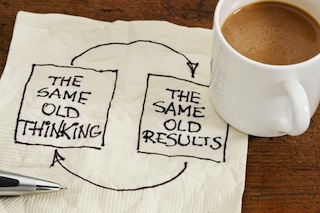 This is a guest post from Dr. Alessandra Wall.
This is a guest post from Dr. Alessandra Wall.
Descartes once said, “I think therefore I am.” He was discussing the nature of self-awareness and identity. Let’s take that statement and change it a bit to help you understand why despite feeling committed, prepared and supported you might find yourself facing set backs in your Primal Blueprint 21-Day Challenge. The statement I want you to keep in mind throughout your challenge and as you read on is the following:
“I think therefore I do.”
What do thoughts have to do with anything?
Do you know why you do the things you do, the way you do them? I’ll let you in on a secret… your behaviors are directly linked to your feelings and your thoughts. Actually, most of what we do is designed to reassure us and reinforce our perception of the world and ourselves.
What does this mean for you and the changes you are trying to make?
It means that any time you try to modify a habit pattern or make a change you can’t simply consider which behaviors you need to modify, without also considering how those behaviors fit into your world, your belief systems. In psychology, the cognitive behavioral theory actually provides a simple model – a universal framework – that can help you understand what your behavior represents, and why you may be struggling to change.
Think about it this way: Every time something happens in your world your brain tries to make sense of it. It wants to understand what a situation means for you and what it says about you. Over time, you form larger assumptions, constructs and beliefs that guide you as you navigate the world, your relationships and your goals. Your thoughts about any given situation dictate how you will feel about it.
Imagine you found out that you won the lottery…
How do you think you would feel?
Excited, ecstatic, relieved, happy? These are emotional responses to the situation, which is winning the lottery.
What is it about winning the lottery that would make you feel that way?
Maybe realizing that you are free of debt; that you can do things that are right now out of financial reach. Maybe there is a dream or project that you will finally be able to pursue. Whatever the reasons might be, these are your thoughts.
What if…
What if the thoughts were different? What if upon winning the lottery the first things that came to someone’s mind were the fact that the IRS was going to take a huge chunk of their winnings or the belief that people and organizations both familiar and unfamiliar would descend upon them for a share of their money? What if they thought about their complete lack of financial savvy and they started to consider that they know nothing about how to invest or protect large sums of money? That would probably change the feelings we listed earlier. Now one could expect anxiety, fear, worry, maybe even anger…
Bottom line: how you feel is not a function of what is happening to you, so much as it is a reaction to your assumptions about the situations you are facing.
What is the personal connection?
So far you know that when you are presented with a situation your brain tries to make sense of it and that is what your thoughts are. Based on your interpretation of a given situation you then form an emotional reaction – your feelings are just a manifestation of your beliefs. Behaviors are simply a more concrete expression of these two factors; they are your solution to a given set of assumptions and the feelings elicited by this reaction.

Often times behaviors help to strengthen our assumptions; by acting in-line with our thoughts we create future situations and circumstances that tend to reinforce those beliefs. It’s a bit like a Facebook feed, the more you click (behavior) “like” on feeds and comments you agree with (thoughts), the more your Facebook world presents you with posts and articles that mirror those that views, thereby reinforcing your beliefs. The same happens in real life. What you do has a personal connection to who you are, and how you see yourself and your world; it is a direct response to your beliefs and your feelings.
Here is a quick example of how that personal connection can hold you back from reaching a goal or resolution:
Many of you are doing the challenge to improve your diet, and lifestyle. You have made a personal commitment to change what and how you eat, as well as how you move. You have made this commitment to yourself because being healthier really matters to you. A likely assumption is that your desire to be healthier, coupled with the right program will unlock the path to a healthier, happier life. This assumption is very important; it is what prompted you to participate in this challenge. Unfortunately, we are complex beings, and you actually have a whole bunch of underlying assumptions, beliefs and personal rules that are also going to positively or negatively impact your chances of success.
I have worked with countless people who have the same hopes and aspirations. Often these assumptions, that desire plus the right plan will equal success are correct, but what if there are other underlying assumptions that get in the way. What if another belief you held about health was that “getting to a place of health is very hard and restrictive,” and that thought combined with a deeper personal belief that “I am not strong”? Can you see how these two underlying assumptions might pose a problem? The first one automatically triggers fear and anxiety, the second helplessness. Together they create a significant barrier any time the process of getting healthier is harder or requires a sacrifice.
In experience as a coach, I can tell you that this kind of thinking is responsible for more failed goals than any kind of physical barrier (such as time constraints or easy access to healthy food options). These types of thoughts, especially the personal beliefs about strength, worth or competence can make the difference between persistence in the face of a challenge versus giving up.
How can you use this in your life?
Recognize that any time you try to make a change you are not only modifying a behavior, but you are challenging a whole cycle of thoughts and feelings.
Given (1), don’t expect big changes to be linear, or easy. Rather understand that the process will involve some great successes and some set backs. I like to tell my clients it’s like the stock market, up close it might look like a bunch of highs and lows, but when you take a step back what you see is upward progress.
When you find yourself struggling with a goal you can try strategizing, but if the best laid out plans don’t seem to be working for you go for the mind. Sit down, and outline what your thoughts and feelings are about both behaviors: the one you are trying to change and the new one you are trying to implement. This will help you understand why you’re not doing what you committed to do.
Use those insights to create a plan that is right for you, one that not only contains the best strategies, but also addresses your assumptions and feelings.
Using the earlier example, you might decide to create smaller steps that don’t feel hard. Steps that you can look at and confidently describe as realistic and feasible – yes that might slow you down, but you’ll get to your finish line. Alternatively, the solution might be thought-based. One of the corrections I have people make all the time is switching the language in their mind from “it’s too hard” to “it’s very hard, but feasible”. If nothing else by now you understand that changing the words in your mind can have a HUGE impact on feelings and actions (caveat – you have to believe what you are saying, it can’t just be positive for the sake of being positive).
Research shows that we have 60,000 to 70,000 thoughts a day. That is 60,000 to 70,000 opportunities to help or hinder your progress. Luckily, the majority of those thoughts are neutral and unremarkable, as are their associated feelings and behaviors. However, some thoughts, feelings and behaviors are defining and can determine the flow and pace of your life. So if you have been struggling to change a behavior or habit despite feeling motivated and having a great plan of action, the one place I recommend you go is to your mind – it holds all the answers!
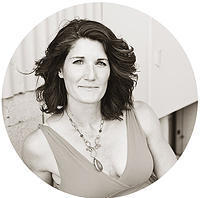 Bio: Alessandra Wall, Ph.D. is a specialist in change. She is psychologist and a life and nutrition coach in private practice in San Diego, California, as well as the Executive Director and Lifestyle and Nutrition Coach at CrossFit Elysium. Her background is in anxiety, stress management and eating disorders. She specializes in helping people create lasting and significant life change, by providing practical insights into the cognitive and emotional factors that typically hold them back. Alessandra has been a featured speaker on topics such as the psychology of change and stress management at several PrimalCon events and Health Unplugged 2014, the UK’s first Paleo/Primal conference. Check out Alessandra’s Change of Heart program to learn how to create and achieve your life goals.
Bio: Alessandra Wall, Ph.D. is a specialist in change. She is psychologist and a life and nutrition coach in private practice in San Diego, California, as well as the Executive Director and Lifestyle and Nutrition Coach at CrossFit Elysium. Her background is in anxiety, stress management and eating disorders. She specializes in helping people create lasting and significant life change, by providing practical insights into the cognitive and emotional factors that typically hold them back. Alessandra has been a featured speaker on topics such as the psychology of change and stress management at several PrimalCon events and Health Unplugged 2014, the UK’s first Paleo/Primal conference. Check out Alessandra’s Change of Heart program to learn how to create and achieve your life goals.



[image error]
Contest: Prizes for Your Thoughts
The Prize:
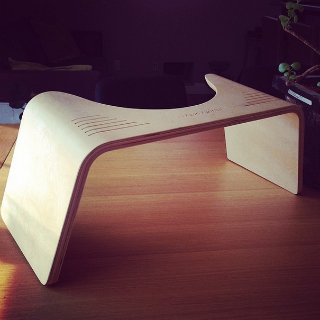 Squatty Potty – You think Grok took a seat on a porcelain throne when nature called? Of course not! Toilets are modern inventions. Grok squatted, and so should you. Why? Well, squatting opens up the colon for fast and easy elimination, which is said to relieve constipation, straining issues, hemorrhoids, bloating and more. But what are we to do? Is it time for all-out bathroom renovations? No, there’s a simpler solution, and that’s where Squatty Potty comes to the rescue. Watch the video below to learn what a Squatty Potty is and win one today by participating in this contest!
Squatty Potty – You think Grok took a seat on a porcelain throne when nature called? Of course not! Toilets are modern inventions. Grok squatted, and so should you. Why? Well, squatting opens up the colon for fast and easy elimination, which is said to relieve constipation, straining issues, hemorrhoids, bloating and more. But what are we to do? Is it time for all-out bathroom renovations? No, there’s a simpler solution, and that’s where Squatty Potty comes to the rescue. Watch the video below to learn what a Squatty Potty is and win one today by participating in this contest!
The first 15 participants of this contest will get a free Squatty Slim. Retail Value: $50 each.
BONUS: Use coupon code MDA15 at checkout and get 15% off your order.
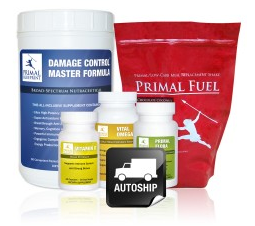 The Primal Blueprint Platinum Package – The Platinum Package is the ultimate in supplementation and is what thousands of Primal enthusiasts and I take daily. It includes: Damage Control Master Formula, Primal Fuel, Primal Flora, Vital Omegas, and Vitamin D booster.
The Primal Blueprint Platinum Package – The Platinum Package is the ultimate in supplementation and is what thousands of Primal enthusiasts and I take daily. It includes: Damage Control Master Formula, Primal Fuel, Primal Flora, Vital Omegas, and Vitamin D booster.
One randomly selected participant will win a Platinum Package.
The Contest:
This one’s simple. If you’ve used any of the Primal Blueprint supplements I’d love to hear from you. Has Primal Fuel helped you eliminate sugar cravings and lose body fat? Has Primal Flora helped to improve your digestion and regularity? Did you reverse a vitamin D deficiency with Primal Blueprint Vitamin D?
Tell me about it by filling out this form.
I get success story emails every day, but I never tire of hearing how the Primal Blueprint family of supplements (books, events and services) have helped people take control of their health and change their lives.
Eligibility:
Only U.S. residents for this one.
The Contest End Time:
January 23, 11:59 PM PST.
How the Winner Will Be Determined:
The first 15 participants get a Squatty Potty. One randomly selected winner gets a Platinum Package.
To track all the contests visit the 2015 Primal Blueprint 21-Day Challenge Contest Page for daily updates.



January 19, 2015
Dear Mark: Your 21-Day Challenge Questions Answered
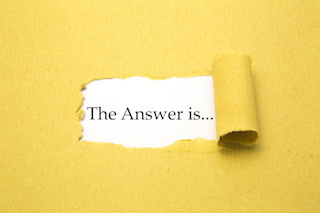 As promised, today’s edition of Dear Mark is all about the 21-Day Challenge. Last week, you asked me a ton of questions. Today, I’m trying to answer as many of them as I can.
As promised, today’s edition of Dear Mark is all about the 21-Day Challenge. Last week, you asked me a ton of questions. Today, I’m trying to answer as many of them as I can.
We’ve got questions about posture, weight loss, dairy, probiotics, alcohol, and much more. Hopefully, you find today’s post useful.
I’ll answer some more next week, so stay tuned for that. Now let’s get to it!
Hi I’m doing the challenge but I’ve been primal for the last year mostly. What would be the most effective bodyweight exercise for correcting a bad hunchback?
The best exercise for correcting a hunchback is maintaining proper posture throughout the day: shoulders back and down. Sadly, there’s no quick fix.
Set a timer to go off every ten minutes. When it goes off, check your posture. Make sure you’re not hunching over with your shoulders rolled forward.
Consider working, at least part of the day, at a standing workstation.
Get a deep tissue massage from someone who specializes in office worker hunchback. You likely have tight anterior shoulders and pectorals (pulling your shoulders forward), so you can also go digging around on those areas with a lacrosse ball.
Check out the posts I did on thoracic mobility, shoulder mobility/stability, and dealing with deskjockery several years back. Do the relevant drills suggested there.
As far as exercises go, pushups, pullups, planks, and bodyweight rows are all excellent for your upper back (and the rest of your body, for that matter).
How do I get my Husband to go Primal? He is fit, healthy, strong, Gorgeous. He lifts weights and he is Chronic Cardio. He believes in conventional wisdom and he drinks diet soda.
Honestly? It sounds like whatever he’s doing is working for him. I wouldn’t stress about the food, because that never goes well. Just slip Primal food into any meals you prepare. Make a side of potatoes instead of bread — that sorta thing.
Focus on the other aspects of Primal, the non-food stuff, that he can get on board with. Sleep, sun, play, pleasure, nature, fresh air, long walks, dinners together. These are all arguably as important as cutting back on sugar or giving up diet soda.
What are your thoughts on weigh-ins and their frequency when doing the challenge primarily for weight loss (although with a view to longer term benefits too)?
Personally, I’m a fan of a pre- and post-Challenge weigh-in. See how much you weigh before starting, and see how much you weigh after. Simple and easy, and if there’s a trend (which is what really matters) over the course of three weeks, you’ll see it.
But I know people like to obsess over the scale. A person’s weight fluctuates hour to hour, meal to meal, bathroom visit to bathroom visit. And since you’re not interested in merely losing weight but losing fat, daily fluctuations are more likely to obfuscate the truth of what’s going on, metabolically, inside.
A good compromise is a weekly weigh-in. That should eliminate the hourly fluctuation factor and give insight to trends.
What’s the best thing you can do when you don’t get enough sleep? Like when all the fire alarms in your house go off in the middle of the night?
So you woke up. Big deal. Don’t make it worse than it already is.
Turn it into an impromptu biphasic sleep session.
Read fiction until you fall asleep.
Do some guided meditations.
Avoid lights and screens (unless wearing blue-blocking goggles).
Do you suggest workouts that focus on one group of muscles or workouts that work your whole body when it comes to weight lifting?
Most people will do best on full body workouts. These pack the most bang for your buck, and targeting more body parts in a single workout provides the largest overall growth stimulus.
More experienced trainees can benefit from splitting their workouts up by muscle group (upper body days and lower body days, for example), but that’s a select group.
I’m currently not drinking and very low carb except for vegetables. Can anyone tell me why I am not losing any weight? Eating between 1,100-1,200 calories a day and working out. Thanks!
That might be too low for you. First off, 1100 calories is already low. And by working out on a regular basis, you’re effectively lowering your calories even further (by using them up).
Consider increasing your calorie count. You may just need to eat a bit more than you are.
Try calorie cycling. Low calorie one day, higher calorie the next. Cycling one’s calorie intake seems to work better than just chronic calorie reduction.
Another thing to try is a carb refeed. Once or twice a week, drop the fat low and bump up the carbs (from Primal sources, of course). This could restore leptin levels and kickstart the fat-burning process.
Hope it works!
If grass-fed/pastured butter is something that we should seek to add to our diets, why is grass-fed cheese (Kerrygold makes a nice cheddar) not something on the “good” list?
Cheese is high in dairy proteins, particularly casein, and many people have a sensitivity or intolerance to dairy protein. If you don’t, then cheese is a great food with a lot of nutrition. But because dairy protein intolerance is relatively widespread, I refrain from giving it the blanket “all good.”
My question is: Is smoked salmon a good choice, or is it better just to grill or bake it?
Smoked salmon is fine, so long as it’s wild. We’ve been using smoke to preserve salmon for centuries.
A 2009 study found that smoking salmon at 95 ºC made the “fragile” fish fats even more oxidatively stable, with a lower peroxide value, fewer TBARS, and fewer free fatty acids, than fresh salmon. That’s right: smoking salmon at a high heat protected the omega-3s from oxidizing to a greater extent than leaving it alone, even if antioxidants were added to the fresh salmon oils. That said, when heating the smoked salmon fat past 75 ºC, peroxides formed at a faster rate than in the fresh salmon fat.
I wouldn’t eat all your salmon smoked, of course. Pound for pound, it’s usually more expensive than fresh or frozen salmon.
You can smoke your own, too, you know.
What’s the best way to handle a spouse who wants to support you in your efforts but isn’t willing to change their own eating habits? That one’s bugging me right now. She just can’t hear what I have to say yet because I don’t have great results at the moment.
Don’t force the issue. This never works. Let your results speak for themselves. Then they’ll come to you. Oh, and those results will come, even if it’s a change in mood, energy levels, or sleep. It doesn’t have to be outwardly apparent to be convincing.
My question: I am trying to fit in some more movement with not a lot of time or opportunity. I see that there are re-bounders that people use, or well, hang in their garage and think they will use, like a mini trampoline. Can a person use one of those for some exercise, 5 minutes here, 10 minutes there?
Totally. Those are a lot of fun. But, yeah, like you say, I notice a lot of people ignoring them after a couple sessions. If you’re set on it and you’re sure you’ll actually use the thing, go for it. Frequent movement (of any sort) is the key here.
You might try finding those people who gave up on the mini trampoline and attempt to purchase it for a lower price than new.
My biggest issue is eating more leafy greens. Is it more beneficial to eat them raw with some high quality olive oil or to lightly fry them with some tallow until soft?
A mix of both.
Some days, have a fresh salad of leafy greens tossed in real extra virgin olive oil. There’s real value in eating raw vegetables from time to time, especially if they’re organic and fresh from the farm (maybe even with a bit of soil left on them).
Other days, do a sauté. This helps you pack more quantity in your meals, as it’s a lot easier to eat six cups of spinach when you wilt it first. By the way, you can cook with extra virgin olive oil, contrary to popular belief. It’s actually a very stable fat.
My question is do you feel it is detrimental to splurge every few months on a favorite “non” food?
Barring consumption of allergenic foods that definitely do harm (like a celiac splurging on a large pizza), I think a splurge, or cheat meal can actually help a lot of people stick to the overall eating plan.
I’m technically lactose intolerant (the 23andme genotype test told me) but I do not see any adverse effects when I eat full fat dairy (or any dairy, for that matter). Should I continue or am I surreptitiously causing all kinds of inflammation by not heeding my genetics? Thanks.
I’m going to go against the grain and say that you should just go with it. If you were truly lactose intolerant, you’d know it when you drank a glass of milk. I suspect you’ve cultivated a microbiome capable of digesting lactose for you. Good work!
And I’m sure you know, but full-fat dairy is definitely worth eating if you can handle it. The health benefits are too numerous to discount and ignore.
Should I really specifically search out grass-fed organic cheese or is any organic cheese that I like just as good/good enough? Thanks.
Grass-fed is definitely superior to just organic. Use the Challenge as a test to see if it makes a subjective difference in how you feel. For some people, switching to grass-fed really does. This is a good opportunity to see if that’s true for you.
A few times I have had people tell me how they will never cook this way again due to the risk of cancer. I even have a family member who is actually getting rid of their grill because they have sworn off this way of cooking!
Is this really that much of a risk? Should I also be considering never grilling again?
Any real science and factual information on this topic would be great! Thanks!
There’s some truth to it. High heat cooking, including but not limited to grilling, does increase the risk of carcinogenic compounds forming. You can mitigate the danger with marinades and cruciferous vegetables. For more tips, check out my posts on gentle cooking methods and the necessity of vegetables in the diet. Rest assured that you can still grill safely and regularly if you take a few precautions.
Everyone says the weight should melt off, but is it possible breastfeeding is making me hold on to those last five pounds?
Yes, it’s fairly common. Body fat helps provide the fatty acids that make up your milk. Some women have the opposite experience, but it’s not nearly as widespread as people make it out to be. Wait till you wean to worry too much.
Where does alcohol fit in the 21-day challenge? Obviously it would be more beneficial for me to cut it out completely.
Try cutting it out altogether. I did a while back, and it worked great for me. It’s not a popular idea, but it’s only 21 days. If you can’t make it the full three weeks, you may have a larger problem on your hands.
I’ll just say it again: the Challenge is a great opportunity to try out some lifestyle changes that you’ve been mulling over.
I had a question around which is worse for you: wine or stress? A couple of glasses of wine at the end of the workday help me relax and unwind, but I’m also trying to lose 45 pounds and know that alcohol is not conducive to fat loss.
Stress is probably worse, but it’s a question of dose. If your stress is a nightly, chronic occurrence and the dose of wine required to mitigate/eliminate it is a glass or two (a real glass, which is about 3 ounces of wine), the wine’s probably worth it. If you need a bottle to take care of the stress, it’s not worth it.
Plus, there are plenty of ways to chill out after a hard day that don’t involve alcohol. Give some of these rituals a shot. And be sure to explore all the other pharmacological ways you can mitigate stress (and a few more).
When you are estimating your carb intake, what do you do with the fiber number? When people say that are eating 50 grams of carbs are they counting the fiber too? Just insoluble fiber? What about soluble fiber?
Don’t count the fiber. It doesn’t turn into glucose, so it doesn’t contribute toward your dietary glucose load.
But don’t discount the fiber. Fiber from fruits, vegetables, and nuts is good, healthy stuff that feeds your gut bacteria and improves your health.
I’m a breastfeeding mother on day 15 of the 21 Day Challenge. I have been doing crossfit style body weight workouts 3 times per week. I have not lost any weight so far, and that’s one of my goals along with other general health goals. Should I be more closely tracking carb counts, calories, etc., or is it enough to just listen to hunger cues?
You shouldn’t dip carbs too low. Breastfeeding generally increases the need for carbs, and so does CrossFit (even if it’s just a ton of high intensity bodyweight exercises, you’re burning glycogen which needs replenishing). As I mentioned to a previous reader, you can simply increase carbs by about 50 grams or so, eating the bulk of them after you workout, or you can try a low-fat, high-carb refeed meal/day once or twice a week.
Hunger cues are usually enough, but not always. Since both your health and your baby’s health are on the line, I’d eat a few more carbs. If you need the carbs (because you’re producing breast milk or burning through glycogen, or both), your body will increase cortisol to stimulate gluconeogenesis (the creation of glucose from protein). Your body gets what it needs either way, but going the cortisol route can inhibit fat burning.
How about integrating probiotics? They are in the “supplements” list in the primal pyramid, but are they any specific real foods you would recommend (biggest bang for your buck) to take care of this, without using supplement, and that would be easy to prepare/make? (PS: I am lactose intolerant)
Sure, there are some things you can try.
Sauerkraut: Since you’re dealing with a lot of material, it’s a bit daunting, but the actual process is easy enough (and fun).
Kefir: The fermentation process takes care of 99% (maybe more) of the lactose in milk, and kefir is loaded with far more bacterial strains than regular yogurt (which is also good, but not lactose-free). It’s also extremely nutrient-dense and may help you digest lactose in its own right. Buy it from a store or make your own using kefir grains. You can usually find someone on Craigslist who has kefir grains to sell or give away.
Unwashed produce from trusted farms/gardens: If you’re dealing with a trustworthy organic farm, eating unwashed produce can introduce soil-based probiotics into your body. I only eat unwashed leafy greens, for example, that I buy from local farmers with whom I’ve struck up a relationship. Learn to like grit.
I am in medical school and am subjected to numerous hours of sitting while I study. What are some ways I can move while still studying?
Take frequent breaks. Walking breaks are ideal (5-10 minutes for every hour of sitting), as they’ll take you physically away from the studying while allowing you to mull over what you’ve just been reading. Short exercise breaks are good, too. Every fifteen minutes, do 15 air squats and 10 pullups, or maybe some jumping jacks, or some walking lunges. Heck, take a kettlebell along with you and do short sets of swings.
The trick is to remind yourself to take the break. Use an online timer to alert you.
How do I get enough daily sun exposure when it’s overcast for weeks on end where I live in the winter?
Vitamin D supplementation is an option.
Sunbeds are an option. Just keep the exposure really short (2-3 minutes) and don’t go more than a three or four times a month, as sunbed radiation is extremely concentrated. Make sure the sunbed you use has a 95:5 UVA:UVB ratio, since that’s the approximate UV ratio of natural sunlight.
But even if there’s no visible sun, it’s still important to get outside during the day and get that natural light into your eyes to help maintain your circadian rhythm. Even obscured by clouds, the sun’s light is bright.
So assuming caloric intake is equal, is there a type of dairy (i.e. fermented vs. fresh) that is less likely to cause weight gain, or would I need to drop it all to test it out?
Although I don’t have any hard evidence, I suspect that fermented dairy is less likely to cause weight gain. A recent study showed that full-fat fermented dairy is better at reducing inflammatory markers (which are often associated with obesity) than either low-fat fermented, full-fat fresh, or (especially) low-fat fresh dairy.
But yes: test it out. Try fermented first.
What is the best workout on the challenge if you are already in adrenal fatigue and not sleeping well? Do you just focus on the diet and come back to fitness later?
Take it easy, but don’t be sedentary:
Stick to long walks, preferably in a nature setting.
You can also throw in some gentle movement, like the sessions described here.
Yoga is worth a shot.
Some light bodyweight movements can work; just keep the reps low, the rest periods high, and avoid getting too out of breath.
That’s it for today, folks. I’ll get back to the questions for the next Dear Mark. Thanks for reading and asking!



Contest: You Might Be Primal If…
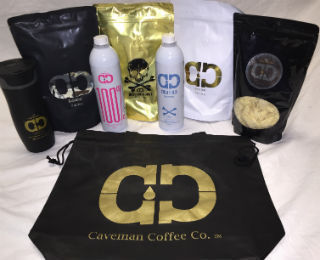 The Prize:
The Prize:
Elite Primal Prize Package from Caveman Coffee – Caveman Coffee Co. was founded by former MMA Fighter, stuntman, and frequent Joe Rogan Podcast guest Tait Fletcher, along with former UFC fighter Keith Jardine, and Lacie Mackey. My Buddy Robb Wolf also serves on their Board of Directors as an adviser to sourcing some of the best nutrition products possible.
Caveman Coffee is not only a Single Origin/Single Estate Coffee, it is a Single Family Coffee. Their beans are grown, washed, dried, and roasted by one family. That’s right, a father and son team run the growing and drying in Colombia and the other two sons handle the small batch roasting.
They’re also proud members of the Specialty Coffee Association of America (SCAA) (less than 10% of the coffee in the word is specialty grade coffee), and hold both the Rainforest Alliance (RAC) and UTZ Certifications. Bottom line, these people are serious about their coffee!
Today’s lucky winner will receive the following: White Gold, Black Listed and Reserve Roast coffees, MCT Oil, Cold Brew, Raw Cacao Butter, Caveman Contigo and a gift tote. Retail Value: $150+.
The Contest:
If you were alive in the mid-1990’s, you may remember comedian Jeff Foxworthy’s empire of “You might be a redneck if…” humor. Today I’m looking for “You might be Primal if…” jokes. Think one up and leave it in the comment board.
Examples:
You might be Primal if you’ve been banned from your local grocery store for repeatedly violating the “No shirt, no shoes, no service” policy.
You might be Primal if you’ve never used an elevator. Ever.
You might be Primal if you prefer your apple with worms.
You might be Primal if you accidentally broke your neighbor’s second story window with a kettlebell.
You might be Primal if every butcher in America can recognize you on the spot.
You might be Primal if you measure friends, relatives, and children not by the mettle of their character, but by how far you could throw them.
You might be Primal if you’ve started to use Tabata intervals for dish washing, shopping, shaving, and dating.
You might be Primal if you make guests take off their shoes before leaving the house.
You might be Primal if you measure time by the number of cows you’ve consumed since an event occurred… “When did we take that trip to Portland?” “Oh, that was about 3 cows ago.”
Eligibility:
Anyone in the world can enter, though this prize may only be available to U.S. contestants. In the case of an international winner, substitute prizes of equal value will be shipped.
The Contest End Time:
Midnight PST, tonight!
How the Winner Will Be Determined:
I’ll pick a handful of my favorites and let all of you decide the winner through a reader poll.
To track all the contests visit the 2015 Primal Blueprint 21-Day Challenge Contest Page for daily updates.



January 18, 2015
Weekend Link Love – Edition 331
 Portland and surrounding environs! The Primal Blueprint Transformation Seminar is coming your way on Thursday, January 29.
Portland and surrounding environs! The Primal Blueprint Transformation Seminar is coming your way on Thursday, January 29.
Research of the Week
Checking your email too frequently increases stress (and it doesn’t even really help us work any better).
Good long naps help babies (and, maybe, larger humans) solidify what they’ve just learned. “Those who sleep after learning learn well, those not sleeping don’t learn at all,” as one researcher put it.
When separated from their ringing phones, iPhone users experience increased blood pressure and heart rate, show symptoms of physiological stress, and perform worse on cognitive tasks.
Compared to eating it with a spoon, eating rice with chopsticks lowers the blood glucose response (PDF).
New Primal Blueprint Podcasts
Episode 50: Mark Interviews Dr. Timothy Noakes: I sit down with a man I’ve long admired, Dr. Tim Noakes. World-renowned sports scientist, purveyor of the famous Central Governor Theory of endurance performance, and author of the endurance training bible The Lore of Running, Tim is now the target of scorn and admonishment from the mainstream medical community for his views on human nutrition.
Each week, select Mark’s Daily Apple blog posts are prepared as Primal Blueprint Podcasts. Need to catch up on reading, but don’t have the time? Prefer to listen to articles while on the go? Check out the new blog post podcasts below, and subscribe to the Primal Blueprint Podcast here so you never miss an episode.
From Desire to Reality: Why Settings Goals Is Critical For Success
It Doesn’t Have to Be This Way
The Primal Blueprint 8 Key Concepts
The Definitive Guide to Feeding Primal Babies
9 More Calorie Myths We Should All Stop Believing
Interesting Blog Posts
Are we having fun yet? (I am.)
“No deaths from vitamins. Absolutely none.” 31 years of data confirm the safety of vitamin supplements.
Media, Schmedia
Joint pain caused by disturbances to the gut? No way, that’s woo-woo pseudoscience!
Jamie Oliver is trying to get UK consumers to buy (and stores to sell) misshapen produce for a reduced price.
Everything Else
If you’ve got an hour to spare, watch this lively presentation by Dr. Michael Holick about the importance of sunlight in human health.
What I wouldn’t give to have a pack of cute, cuddly wolf cubs living in my gut.
Boy, the Japanese and Scandinavians can really turn a phrase.
Hippos are pretty incredible. And they’re far from hippies.
Where in North America the buffalo used to, but, sadly, no longer roam.
Recipe Corner
You’ll inevitably find yourself humming “Wild Thing” when you make Wild Thing Texas Chili.
Bet you haven’t tried roasted cabbage before.
Time Capsule
One year ago (Jan 18 – Jan 24)
Are Parasites Primal? – Parasites might not be all bad. There’s evidence that they help regulate our immune response.
15 Reasons to Sprint More This Year – Sprinting is a powerful tool that, if used in moderation, can reshape your body, your fitness, and your overall health.
Comment of the Week
Mine is “stay on target… stay on target…”.
– Let’s hope it works better for you than it did for Gold Team during their Death Star trench run.



January 17, 2015
Paleo Pancakes Two Ways (Plus a Contest!)
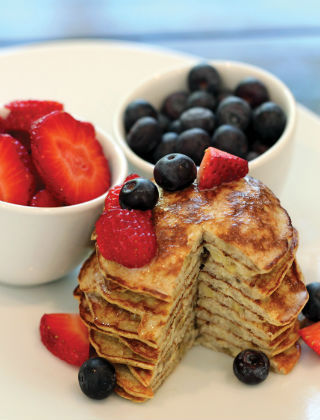 Hey, primal pals. Leslie Klenke here! You may know me from Primal Blueprint Publishing’s 2014 release Paleo Girl, my MDA Success Story, the Primal Blueprint Certified Expert Directory, or maybe you took one of my workshops at last year’s PrimalCon. I was so excited when Mark asked me to write a guest post today that I decided I was going to treat you all to two recipes!
Hey, primal pals. Leslie Klenke here! You may know me from Primal Blueprint Publishing’s 2014 release Paleo Girl, my MDA Success Story, the Primal Blueprint Certified Expert Directory, or maybe you took one of my workshops at last year’s PrimalCon. I was so excited when Mark asked me to write a guest post today that I decided I was going to treat you all to two recipes!
Let me start by saying I love breakfast, and I have no shame in admitting that I’ve eaten breakfast food for every meal of my day on more than one occasion. My go-to favorite is eggs over medium paired with bacon and avocado—but sometimes it’s fun to be a little indulgent. Sometimes you just need pancakes.
Banana Pancakes and Almond Pancakes are my favorites—not to mention they’re incredibly versatile. You might recognize the same ingredients (but different instructions) in the Banana Pancakes as you’ll find in my Better Than Oatmeal recipe that Mark shared on the blog when Paleo Girl launched. Not to mention, Almond Pancakes can be used as “buns” for breakfast sandwiches stuffed full of eggs, bacon, and whatever else your little paleo heart desires.
For pancake emergencies, download and print the convenient recipe cards I’ve created below!
If you’re looking for more paleo recipes or inspiration, check out my website or like/follow me on Instagram, Twitter, and Facebook.
Have a happy weekend full of health, love, and pancakes!
Leslie
Banana Pancakes

Servings: 9 pancakes
Time in the Kitchen: 15 minutes
Ingredients:
1 ripe banana
2 eggs
A pinch of cinnamon
A splash of vanilla
Butter (for cooking and topping)
Instructions:
Add banana, eggs, cinnamon, and vanilla to a medium bowl and mash together. Grease skillet with butter and turn on stove to medium heat. Pour batter in skillet to make a three- to four-inch wide pancake.
Cook until lightly browned on one side, then carefully flip pancake. Continue cooking until pancake is cooked throughout.
Repeat until batter is gone; re-greasing skillet between each batch of pancakes.
Almond Pancakes

Servings: 3 pancakes
Time in the Kitchen: 7 minutes
Ingredients:
1/3 cup almond flour
1 egg
A pinch of cinnamon
A splash of vanilla
Butter (for cooking and topping)
Instructions:
Add almond flour, egg, cinnamon, and vanilla to a medium bowl and mix well. Grease skillet with butter and turn on stove to medium heat. Pour batter in skillet to make a three- to four-inch wide pancake.
Cook until lightly browned on one side, then carefully flip pancake. Continue cooking until pancake is cooked throughout.
Repeat until batter is gone; re-greasing skillet between each batch of pancakes.
Now, For the Contest!
The Prize:
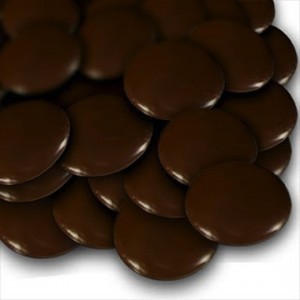 Santa Barbara Chocolate is the supplier of some of my favorite chocolate, and they’ve been a more than welcome sponsor of PrimalCon since the very beginning, donating boxes of dark chocolate coins for guests to enjoy (not to mention some pretty special dark chocolate truffles made just for us). PrimalCon attendees can attest, their chocolate is top notch.
Santa Barbara Chocolate is the supplier of some of my favorite chocolate, and they’ve been a more than welcome sponsor of PrimalCon since the very beginning, donating boxes of dark chocolate coins for guests to enjoy (not to mention some pretty special dark chocolate truffles made just for us). PrimalCon attendees can attest, their chocolate is top notch.
With over 120 years of combined experience, Santa Barbara Chocolate prides themselves on bringing the finest sourced chocolate to the online market. They have formed close relationships with their partners around the globe to make buying high end chocolate brands at wholesale prices easy and affordable.
3 Lucky Winners will be chosen at random to win one of the following:
First Place: Any choice of 3 x 3 lbs of Pure Chocolate, 9 lbs. Total. Retail Value: $126.
Second Place: Any choice of 2 x 3 lbs. of Pure Chocolate, 6 lbs. Total. Retail Value: $87.
Third Place: Any choice of 1 x 3 lbs. of Pure Chocolate, 3 lbs. Total. Retail Value: $48.
BONUS: Use promo code PRIMAL-BLUEPRINT for 12% of any order.
The Contest:
This one is for all the recipe crazed Pinterest folks! All you have to do is enter below-
Contest Deadline:
January 18, 11:59 PDT.
Choosing a Winner:
Three entries from the above widget will be chosen at random.
Eligibility:
Anyone in the world can enter, though this prize may only be available to U.S. contestants. In the case of an international winner, substitute prizes of equal value will be shipped.
To track all the contests visit the 2015 Primal Blueprint 21-Day Challenge Contest Page for daily updates.
Not Sure What to Eat? Get the Primal Blueprint Meal Plan for Shopping Lists and Recipes Delivered Directly to Your Inbox Each Week


January 16, 2015
Challenging Conventional Thinking Left Me 100 Pounds Lighter and Medication-Free
It’s Friday, everyone! And that means another Primal Blueprint Real Life Story from a Mark’s Daily Apple reader. If you have your own success story and would like to share it with me and the Mark’s Daily Apple community please contact me here. I’ll continue to publish these each Friday as long as they keep coming in. Thank you for reading!
 My family is from Scotland and, when I was just shy of four, we moved to St. Louis, which is still my home. I was an active kid who loved playing in the woods more than traditional sports, although I did play soccer for a few years. When I was 17, my father died of cancer of the esophagus at the age of 48. This triggered a depression that would follow me for years. I worked long hours—a night shift job I absolutely hated. I started packing on pounds and, before long, I was 215 lbs of fat. I’m just under 5’9”. At the time, I was in my early 20’s and single, so I tried a popular diet program back then—one where you join the program, meet with a counselor, and buy all of your meals. They asked what you wanted to weigh and would give you your money back if you kept the weight off for one year. I went from 215 lbs to 169 lbs in less than three months, eating only their food and bike riding. Some people thought I was ill. All I cared about were the numbers on the scale. I quit the program the day I reached my goal of 169 lbs and quickly started to gain my weight back with a vengeance. I got married a year later and by then was 205 lbs. Everyone said I looked fit and was very happy over all, but I wasn’t eating the program’s food anymore. I hadn’t learned any nutritional lessons, and I was back to my old ways.
My family is from Scotland and, when I was just shy of four, we moved to St. Louis, which is still my home. I was an active kid who loved playing in the woods more than traditional sports, although I did play soccer for a few years. When I was 17, my father died of cancer of the esophagus at the age of 48. This triggered a depression that would follow me for years. I worked long hours—a night shift job I absolutely hated. I started packing on pounds and, before long, I was 215 lbs of fat. I’m just under 5’9”. At the time, I was in my early 20’s and single, so I tried a popular diet program back then—one where you join the program, meet with a counselor, and buy all of your meals. They asked what you wanted to weigh and would give you your money back if you kept the weight off for one year. I went from 215 lbs to 169 lbs in less than three months, eating only their food and bike riding. Some people thought I was ill. All I cared about were the numbers on the scale. I quit the program the day I reached my goal of 169 lbs and quickly started to gain my weight back with a vengeance. I got married a year later and by then was 205 lbs. Everyone said I looked fit and was very happy over all, but I wasn’t eating the program’s food anymore. I hadn’t learned any nutritional lessons, and I was back to my old ways.
I settled into married life with kids and was now working long hours at a desk job. Each year, another five or so pounds of fat appeared on my body and I would get more depressed. I also started to cough a lot and have acid reflux, or GURD, to the point where I could not leave the house without a pack of Tums or Rolaids. My blood pressure was always good at my doctor visits and I was not concerned, even though I now weighed 270 lbs. My wife loved me, my doctor said my blood pressure and cholesterol were fine, and life was good overall. So, I just ignored my weight.
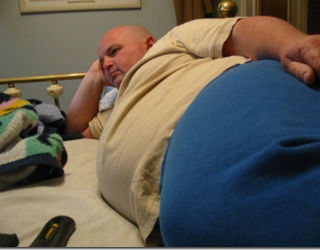 My wakeup call came when I was approaching my 48th birthday (the age of my dad’s death). I was now over 315 lbs and had quit looking at a scale after that. I was on prescription meds for my GURD and, now, my doctor wanted me to take pills because my blood levels were borderline diabetic. I was tired all the time, I overate, and I knew, after years of denial, I was the fattest man in my office, in my family, and in any group of my friends. I hated to see pictures of myself because, even knowing I was so out of shape, I just did not want to accept that it was that bad.
My wakeup call came when I was approaching my 48th birthday (the age of my dad’s death). I was now over 315 lbs and had quit looking at a scale after that. I was on prescription meds for my GURD and, now, my doctor wanted me to take pills because my blood levels were borderline diabetic. I was tired all the time, I overate, and I knew, after years of denial, I was the fattest man in my office, in my family, and in any group of my friends. I hated to see pictures of myself because, even knowing I was so out of shape, I just did not want to accept that it was that bad.
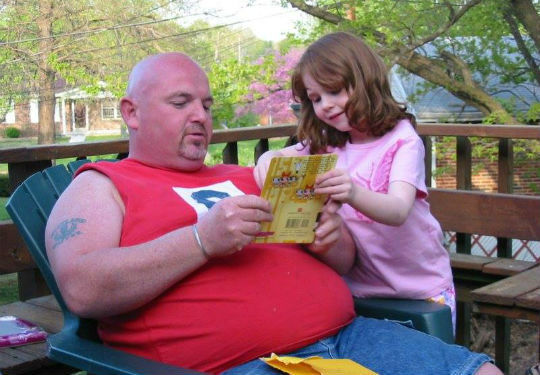
So, I started researching, which is something I really enjoy. I read every health magazine I could get my hands on. I watched TV shows and documentaries. I built of a stack of knowledge on weight loss and health and I would eat pizza and drink beer as I “learned.”
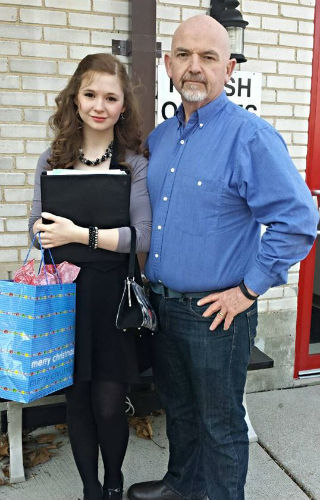 At long last, I found The Primal Blueprint and every word spoke to me. “Challenge conventional thinking” was perhaps the most important line in the book for me. Mark’s program was something I felt I could actually do, as opposed to just something else I could learn, but not accomplish. I decided I could at least walk and I knew I could bike ride, from my days before I was married. So, I forced myself to take daily walks, increasing my distances over time. I fixed up my old bike and added that to my routine. As I felt better, I added hiking. To change my diet, I learned all sorts of ways to cook eggs and make salads. I added foods like avocados, healthy snack alternatives, and I started to shop at our local farmers market. It took three months to lose the sugar cravings but they did finally disappear. I was becoming more primal each day in my manner of living. I was still stuck in the mode of checking the scale all the time, but it was OK, as I learned to not give up if the number wasn’t what I wanted or expected. I started on November 1st, my wife’s birthday, and by my birthday the following August, I was down to 210 lbs!
At long last, I found The Primal Blueprint and every word spoke to me. “Challenge conventional thinking” was perhaps the most important line in the book for me. Mark’s program was something I felt I could actually do, as opposed to just something else I could learn, but not accomplish. I decided I could at least walk and I knew I could bike ride, from my days before I was married. So, I forced myself to take daily walks, increasing my distances over time. I fixed up my old bike and added that to my routine. As I felt better, I added hiking. To change my diet, I learned all sorts of ways to cook eggs and make salads. I added foods like avocados, healthy snack alternatives, and I started to shop at our local farmers market. It took three months to lose the sugar cravings but they did finally disappear. I was becoming more primal each day in my manner of living. I was still stuck in the mode of checking the scale all the time, but it was OK, as I learned to not give up if the number wasn’t what I wanted or expected. I started on November 1st, my wife’s birthday, and by my birthday the following August, I was down to 210 lbs!
The amount of attention I got through Facebook and from friends and family because of my weight loss was wonderful for my ego. But nothing was better than the day my doctor took me off all of my medicine and asked me how I did it! ME! I started writing a blog called Haver Wisdom, where I share my story with a lot of pictures of my fat self. I always give full credit to you, Mark, and your wonderful site, Mark’s Daily Apple, which I still visit daily for tips, inspiration, and support.
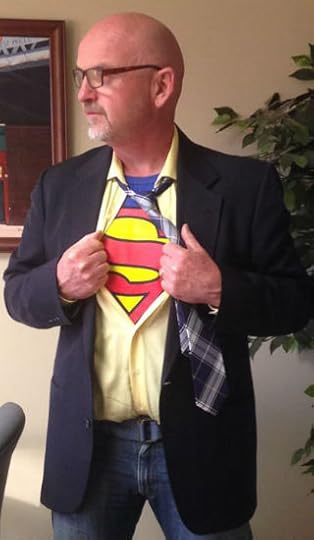 I continue to work on my health. I’m now 51 and I went from wearing a size 42 in jeans to a size 34, which are getting a little too baggy as I write this. My wife bought me a fancy blender and now I start my days off with a smoothie made of almond milk, blueberries, and banana. Lunch is a protein shake and a mile walk, and dinner is a salad with meat most days.
I continue to work on my health. I’m now 51 and I went from wearing a size 42 in jeans to a size 34, which are getting a little too baggy as I write this. My wife bought me a fancy blender and now I start my days off with a smoothie made of almond milk, blueberries, and banana. Lunch is a protein shake and a mile walk, and dinner is a salad with meat most days.
All of my depression is gone. All my medications are gone. I feel stronger every day. I work out several times a week, each session for less than twenty minutes, with a kettlebell and dumbbells. I also enjoy my daily long, slow walks and bike rides, when weather and time permit. But, I also bought a wearable fitness monitor, so, even on days when I can’t get one long exercise goal, like a walk or bike ride, I can still make sure I at least get in 10k steps every day, no matter what.
My goal for 2015 is to have fun as I add muscle and firm up, since I still have some loose skin from losing over 100 lbs. Life is great, I feel like I’ll be here long-term for my wife and my family, I have a lot of fun, and I feel I owe a huge thank you to you, Mark, for The Primal Blueprint.
Grok on!!
Mark



Contest: Ask Me a Question. Win Fat.
The Prize:
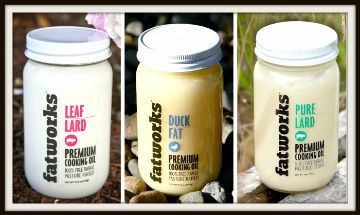 Fatworks Premium Fats – Fatworks big fat mission: to educate the mainstream population about the benefits of using REAL cooking oils like tallow, lard and duck fat while crafting these traditional fats the most natural way possible. For years fat has been slandered, beat up, picked on and falsely accused! But no longer, for we are the Defenders of Fat! Far from being unhealthy, new research strongly supports the idea that fat works as a vital part of a healthy and balanced lifestyle. If you are passionate about cooking with the highest quality foods and understand the importance of real fat then you already know Fatworks. And to you we say, “Welcome Fellow Fatworker!” Glad you finally arrived.
Fatworks Premium Fats – Fatworks big fat mission: to educate the mainstream population about the benefits of using REAL cooking oils like tallow, lard and duck fat while crafting these traditional fats the most natural way possible. For years fat has been slandered, beat up, picked on and falsely accused! But no longer, for we are the Defenders of Fat! Far from being unhealthy, new research strongly supports the idea that fat works as a vital part of a healthy and balanced lifestyle. If you are passionate about cooking with the highest quality foods and understand the importance of real fat then you already know Fatworks. And to you we say, “Welcome Fellow Fatworker!” Glad you finally arrived.
The winner of today’s contest will get a four pack of the following premium fats: 1 Fat Bastard* (that’s a half gallon brick of Fatworks Grass Fed Tallow), 1 jar of Pasture Raised Leaf Lard, 1 jar of Pastured Raised Pure Lard and 1 jar of Pasture Raised Duck Fat.
BONUS: Use promo code PrimalFat for 15% off any order.
*Check out Fatworks on Twitter, Instagram, and Facebook.
The Contest:
Today’s contest is a piece of cake. Simply leave a comment below asking me your 21-Day Challenge questions. Need some advice? Struggling with something? Anything? Let me know in the comment board. Just make sure that your questions are related to your 21-Day Challenge in some way. I’ll be answering as many questions as I can in this coming Monday’s Dear Mark post.
Replying to questions with answers also counts. This is a community effort, so share your tips and tricks with those in need of some help and you’ll also be entered to win.
Contest Deadline:
Midnight tonight, January 16th.
Choosing a Winner:
Three comments, and thus three winners, will be chosen at random.
Eligibility:
Anyone in the world can enter, though this prize may only be available to U.S. contestants. In the case of an international winner, substitute prizes of equal value will be shipped.
Other Important Info:
Remember to use your real email address in the comment board. If you don’t we won’t have a way to contact you.
Multiple comments won’t get you multiple entries. But by all means, ask or answer away.
To track all the contests visit the 2015 Primal Blueprint 21-Day Challenge Contest Page for daily updates.



[image error]
Mark Sisson's Blog
- Mark Sisson's profile
- 199 followers



